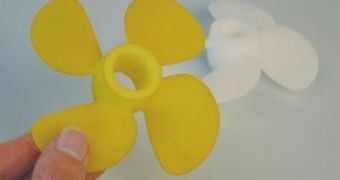In case you did not know, CO2 doesn't just contribute to global warming, it can also be a useful product, especially in the chemical industry, where it can be used to produce urea (a fertilizer), methanol (fuel additive) and salicylic acid (ingredient of aspirin).
A team of researchers from the Fraunhofer Institute for Environmental, Safety and Energy Technology UMSICHT in Oberhausen believed that CO2 can do so much more, so they started testing whether it can be used to impregnate plastics, and found their theory to be true.
Furthermore, during their tests, the scientists even managed to impregnate polycarbonate with nanoparticles giving it antibacterial properties.
They tested the antibacterial surface by placing E. coli bacteria on it – in the institute's own high-pressure laboratory, killing off completely.
This could be very useful in hospitals, where surfaces could be impregnated with the same nanoparticles, limiting the very dangerous MRSA infections.
The researchers also carried out tests with silica and flurbiprofen – an anti-inflammatory active pharmaceutical ingredient, and they were also successful.
Dipl.-Ing. Manfred Renner, a scientist at Fraunhofer UMSICHT, said that the “process is suitable for impregnating partially crystalline and amorphous polymers such as nylon, TPE, TPU, PP and polycarbonate,” its only flaw being that “it cannot be applied to crystalline polymers.”
And since carbon dioxide is non-flammable, non-toxic and cheap, this process holds enormous potential.
Also, even if it shows solvent-like properties, it doesn't have the same dangerous effects on health and on the environment as the current solvents that are used in paints, for example (painted surface are non resistant to scratches, and damage easily), and it seems like the safest and most durable way of impregnating plastics.
The process consists in bringing the CO2 at a temperature of 30.1º Celsius and a pressure of 73.8 bar, so that it goes into a supercritical state, allowing it to have solvent-like properties.
Once it's done, it can be introduced into polymers, or act as a 'carrier' in which can be dissolved dyes, additives, medical compounds and other substances.
"We pump liquid carbon dioxide into a high-pressure container with the plastic components that are to be impregnated, then steadily increase the temperature and the pressure until the gas reaches the supercritical state.
“When that state is reached, we increase the pressure further,” explains Renner.
“At 170 bar, pigment in powder form dissolves completely in the CO2 and then diffuses with the gas into the plastic.
“The whole process only takes a few minutes.
“When the container is opened, the gas escapes through the surface of the polymer but the pigment stays behind and cannot subsequently be wiped off.”
Renner explains that this “method allows us to customize high-value plastic components and lifestyle products such as mobile phone shells.
“The best about it is that the color, additive or active ingredient is introduced into layers near the surface at temperatures far below the material's melting point, in an environ mentally friendly manner that does away with the need for aggressive solvents.”
The process could also be used in contact lenses, for dying them or adding pharmaceutical compounds that would be gradually released to the eye throughout the day, replacing the eye drops for the treatment of glaucoma.

 14 DAY TRIAL //
14 DAY TRIAL //